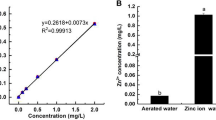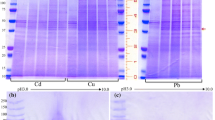Abstract
The potential of cadmium, zinc, and lead to interact with calmodulin (CaM) was investigated by examiningin vitro CaM-dependent protein phosphorylation in tissues from rainbow trout (Oncorhynchus mykiss) and sea mussel (Mytilus sp.) and CaM-dependent phosphodiesterase (PDE) activation by algal (Chlamydomonas reinhardtii) extracts. Cadmium, zinc, and lead proved effective in sustaining CaM-dependent protein phosphorylation in systems containing calcium, whereas only lead was capable of CaM activation in systems depleted of calcium. Cadmium lead to a small activation of CaM-dependent PDE activity by algal extracts, corresponding to ∼25% of that induced by calcium. Cadmium-induced PDE-activation could be attributed to the residual calcium present in the extract. The results indicate that metal-induced CaM activation is primarily mediated in the case of cadmium and zinc by resulting calcium/CaM complexes and in the case of lead by lead/CaM complexes.
Similar content being viewed by others
References
Behra R, Gall R (1991) Calcium/calmodulin-dependent phosphorylation and the effect of cadmium in cultured fish cells. Comp Biochem Physiol 100C:191–195
Bradford MM (1976) A rapid method for the quantification of microgram quantities of protein using the principle of dye binding. Anal Biochem 72:248–254
Chao S-H, Suzuki Y, Zysk JR, Cheung WY (1984) Activation of calmodulin by various cations as a function of ionic radius. Mol Pharmacol 26:75–82
Cheung WY (1980) Calmodulin plays a pivotal role in cellular regulation. Science 207:19–27
— (1984) Calmodulin: its potential role in cell proliferation and heavy metal toxicity. Federation Proc 43:2995–2999
Dreisbach RH (1983) Handbook of poisoning: prevention, diagnosis and treatment, 11th ed Lange Medical Publications, Los Altos, CA
Flik G, Van de Winkel JGJ, Pärt P, Wendelaar Bonga SE, Lock RAC (1987) Calmodulin mediated cadmium inhibition of phosphodiesterase activity,in vitro. Arch Toxicol 59:353–359
Förstner U, Wittmann GTW (1981) Metal pollution in the aquatic environment, 2nd revised ed. Springer-Verlag, Berlin
Geiser JR, van Tuinen D, Brockerhoff SE, Neff MM, Davis TN (1991) Can calmodulin function without binding calcium? Cell 65:949–959
Goldstein GW, Ar D (1983) Lead activates calmodulin sensitive processes. Life Sci 33:1001–1006
Habermann E, Crowell K, Janicki P (1983) Lead and other metals can substitute for Ca2+ in calmodulin. Arch Toxicol 54:61–70
Jones HS, Fowler BA (1980) Biological interactions of cadmium with calcium. Ann NY Acad Sci 355:309–318
Klee CB, Vanaman TC (1982) Calmodulin. Adv Protein Chem 35:213–321
Lämmli UK (1970) Cleavage of structural proteins during the assembly of the head of bacteriophage T4. Nature (Lond) 277:680–685
Lewis TL, Yuan Y, Haug A (1990) Calmodulin concentration in mucus of rainbow trout,Salmo gairdneri, exposed to combinations of acid, aluminum, and calcium. Bull Environ Contam Toxicol 44:449–455
Markovac J, Goldstein GW (1988) Picomolar concentrations of lead stimulate brain protein kinase C. Nature (Lond) 334:71–73
Mazzei GJ, Girard PR, Kuo JF (1984) Environmental pollutant Cd2+ biphasically and differentially regulates myosin light chain kinase and phospholipid/Ca2+-dependent protein kinase. FEBS Lett 173:124–128
Nordberg GF, Fowler BA, Friberg L, Jernelov A, Nelson N, Piscator M, Sanstead HH, Vostal J, Vouk VB (1978) Factors influencing metabolism and toxicity of metals: a consensus report. Environ Health Perspect 25:3–41
Sillen LG, Martell A (1971) Stability constants, Suppl. No. 1, Special Publication 25, The Chemical Society. Burlington House, London
Simons JJB (1986) Cellular interactions between lead and calcium. Br Med Bull 42:431–434
Smith RM, Martell AE (1975) Critical stability constants, Vol 3. Plenum Press, New York
Staub R (1961) Ernährungsphysiologisch-autökologisch Untersuchungen an der planktischen BlaualgeOscillatoria rubescens. Schw Z Hydro 23:82–198
Suzuki Y, Chao S-H, Zysk JR, Cheung WY (1985) Stimulation of calmodulin by cadmium ion. Arch Toxicol 57:205–211
Van Belle H (1981) R 24571: A potent inhibitor of calmodulin-activated enzymes. Cell Calcium 2:483–493
Verbost PM, Flik G, Lock RAC, Wendelaar Bonga SE (1988) Cadmium inhibits plasma membrane calcium transport. J Membr Biol 102:97–104
Verbost PM, Van Rooij J, Flik G, Lock RAC, Wendelaar Bonga SE (1989) The movement of cadmium through freshwater trout branchial epithelium and its interference with calcium transport. J Exp Biol 145:185–197
Viarengo A (1985) Biochemical effects of trace metals. Mar Pollut Bull 16:153–158
Westall J (1979) MICROQL, a chemical equilibrium program in BASIC, Internal Report. EAWAG, Dübendorf
Author information
Authors and Affiliations
Rights and permissions
About this article
Cite this article
Behra, R. In vitro effects of cadmium, zinc and lead on calmodulin-dependent actions inOncorhynchus mykiss, Mytilus sp., andChlamydomonas reinhardtii . Arch. Environ. Contam. Toxicol. 24, 21–27 (1993). https://doi.org/10.1007/BF01061085
Received:
Revised:
Issue Date:
DOI: https://doi.org/10.1007/BF01061085




